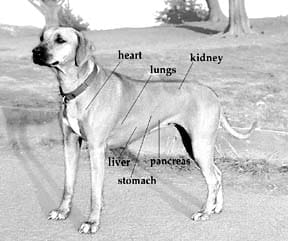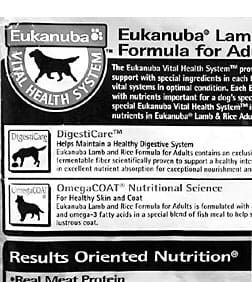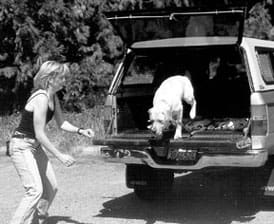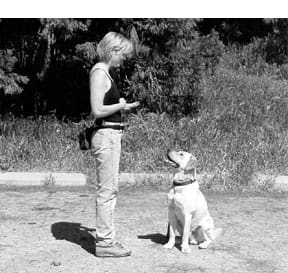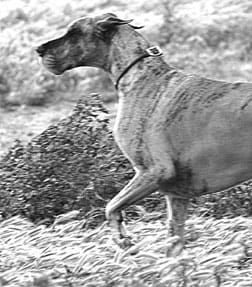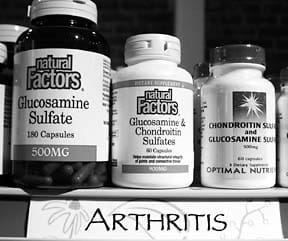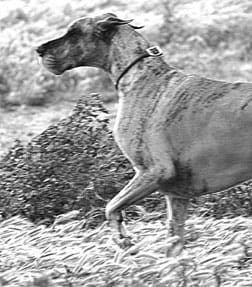Fight Against Cancer
I just lost my dear buddy, Brando, a wonderful Rottie, to cancer. It was a brief but utterly intense battle. I found Brando at work two and a half years ago. I know God sent me this dog; he was the greatest gift I have ever received. He was totally mellow and loved all creatures. Part of our journey together was to help the world be more “Rottie friendly.” We achieved that goal a bit but also occasionally felt the pain of “Rottie racism.”
Thank you for the wealth of information on canine cancer you have published; it started my journey to find help for Brando. After being brushed aside by the regular veterinarians with Prednisone and their best wishes, I started feeding him all kinds of concoctions based on all the nutritional information in your articles (“The Canine Cancer Crisis,” Oct. 1998, “Choosing the ‘Best’ Treatment,” Nov. 1998, and “Eating Right to Fight Cancer,” Dec. 1998). Also, I was lucky enough to find a wonderful vet – Smith Ridge Veterinary Center in South Salem, NY, and Dr. Kreusi – who provided very good care. They did a complete nutritional and metabolic analysis and prescribed foods and supplements. They recommended mushroom and glandular extracts and started their Immuno Augmentative Therapy.
Unfortunately, it was too late; Brando started to decline. It was so sad and frustrating. Two weeks after our first vist with Dr. Kreusi, Brando went back to the vet center for a three-day stay. When I arrived to pick him up I knew that he was starting to suffer and made the decision to put him to sleep. I could tell by his behavior that he wanted to go to the other side.
My heart is broken but I know I made the right decisions for him. What I have lost can never be replaced but I also have gained so much knowledge about this disease and what we can do to prevent it. I will continue to subscribe to WDJ even though I think I will be dogless for a while. I also must thank Diana Hayes, someone I met on the Internet from Australia, for helping me and answering my letters in a timely way.
-Diane Durden
via email
Favorite Arthritis Supplements
In our April 1999 issue, we discussed the nutraceutical supplements called glycosaminoglycans (GAGs, for short) that are becoming increasingly popular for treating arthritic conditions in people and dogs. We asked readers for their experiences with the supplements – and their responses were all positive:
My Boxer began limping after energetic play about three years ago. X-rays showed arthritis in her left elbow and knee. My sister-in-law recommended a supplement called Amaize. Within a few weeks I saw marked improvement and I am happy to report that Suzy hasn’t limped since – and she plays with enthusiasm, including running up and down an outdoor staircase.
-Cheryl Feight
Burbank, South Dakota
Amaize is made by Marsland Laboratories, (800) 941-8666.
Two years ago I realized something was wrong with Jackson, my Irish Setter (he was six years old then). When he tried to jump on the bed, he would have a hard time; if I lifted his rear end to help him, he would whine. He also had a slight limp. He was diagnosed with caudal equine syndrome, and surgery was recommended.
Instead, I started giving Jackson a daily glucosamine supplement called K-9 Freedom and an essential fatty acid supplement. I did this for about six months, and then switched to GlycoFlex. My veterinarian is amazed at how well Jackson is doing. This regimen has delayed (if not eliminated) surgery, and Jackson still runs 2-3 times a week.
-Leslie Lawrence
Fremont, CA
After trying many different combinations of things for myself and my Bull Mastiff, who has osteochondritis of the elbows, we have had phenomenal success using GlycoFlex purchased through KV Vet Supply (which is cheaper than getting it from our vet.) Yes, I take it, too! I did research at the Tufts Veterinary Medical School library years ago to find the components that appeared to be most successful to help arthritic conditions. This is it! We take one large tablet a day, along with vitamins E and C. As long as we remain on this regimen and keep our weight in check, we are virtually pain-free!
-Jill Lashua
Shirley, MA
GlycoFlex is made by Vetri Science Laboratories, a division of Foodscience Corp., (800) 451-5190.
After researching and experimenting with multiple remedies for my animals over the past six years, I disagree that the focus should be on the quantity and purity of the GAGs you purchase. I tried pure forms of chondroitin sulfate (CS) and glucosamine on a chronically arthritic horse and saw no improvement. With further research, I learned that these substances, especially CS, are not well-absorbed by the intestinal tract.
It is ironic that the product I have obtained the most results from is Joint Jolt – the product criticized by WDJ for not indicating the quantity of CS. The manufacturer has (correctly) created an array of ingredients that complement each other to increase the absorption and beneficial effects on all systems that stimulate healthy cartilage. This seems to be more appropriate for holistic healing, rather than looking for the silver bullet as with conventional drug therapies. Treat the whole animal – not the disease!
-Darlene Drew
Chicago, IL
Joint Jolt is made by Advanced Biological Concepts, (800) 373-5971.
Here at the Heart and Soul Animal Sanctuary, we have had several dogs on GAG supplements for several years with outstanding results. The dogs are from 11 to 15 years of age and are given the supplements in their food, morning and night. The dosage varies according to severity of the arthritic condition. We use three products from Vita Flex Nutrition: Proanthozone, Chondroitin Sulfates, and Glucosamine Sulfate (with ascorbic acid). These supplements definitely provide improvement in the connective tissue of dogs. Our old dogs go on long walks (about two miles) three times a week, and enjoy themselves thoroughly. Exercise is essential! Plus, all our dogs receive vitamin C daily, whether they are three months old or 16 years old.
-Natalie Owings, Director
Heart and Soul Animal Sanctuary
Santa Fe, NM
The Vita-Flex Nutrition Co. can be reached at (800) 848-2359.
Our company has decided to include chondroitin sulfate and glucosamine in some of our Super Premium dog foods.
Caution is needed when buying supplements. We talked with a Ph.D., a state chemist in charge of large and small animal feeds. In laboratory tests of chondroitin and glucosamine supplements, he found that about 30 percent of products tested had zero levels of the stated active ingredient, 30 percent had less than the amount guaranteed, and the balance had the amount guaranteed.
According to the FDA it is illegal to include the two ingredients in pet food, though a few companies do. We expect this to change in August and will then include the two ingredients in several of our products.
-John Marsman
Director Nutritional Services
Eagle Products, Inc., Mishawaka, IN
US (800) 255-5959
Canada (800) 235-5959
The GAG products get raves from me! I bought the most beautiful silver German Shepherd pup in the spring of 1997. But at seven months, she pulled up lame on her rear legs. She wouldn’t put one leg on the ground. After X-rays, my vet told me she had very serious hip dysplasia. His advice was to keep her confined, with little activity. He put her on pain pills, and said when she was one to two years old, she could have hip replacement surgery, but his advice would be to put her to sleep.
I started researching diet, vitamins, etc. Finally, I came across an article on GAG products, and bought a product called Arthramine. I started her on it right away, and in a couple of weeks she was a new dog! I stopped the pain pills; she doesn’t need them. Her activity level has increased, and with supervision she runs, easy, with my other dogs. GAGs have given us hope for a future together.
-Peggy Grabias
Sanford, MI
Arthramine is made by Vesta Nutritional Products, and sold by Health Plus Corp., (800) 704-9790.
We at KR Natural Pet Products strive to inform our customers as fully as we can with our labels. You expressed concern about our InflamAway label, which states 1500 mgs per wafer. Your concern was that readers might think the label meant the product contained 1500 mgs of glucosamine . . . However, the product we market is a formula, i.e., a combination of nutrients that includes glucosamine and other ingredients. The other ingredients make up a very important part of the reason why this is such a great product.
InflamAway has been helping pets to be free of pain and discomfort since 1990. We correctly state that the total weight of the formula is 1500 mgs per tablet, and our label lists active ingredients and their weights very explicitly. We also market a product that we call “Glucosamine 500 Chondroitin 400” with exactly those weights listed on the label.
Our company promotes education and better awareness to help our pets lead healthier and happier lives. We do find that better educated consumers make better customers.
-Stephen Khang, Sales Manager
KR Natural Pet Products, Calabasas, CA
(818) 347-0387
FYI, Walgreen’s Extra Strength Glucosamine/Chondriate has the same combination/strength of ingredients as does Cosequin, at $30 less per 120 capsules. With a few added tabs of vitamin C, both my 11-year-old Airedale and I have vastly improved in flexibility and lessened pain. We have both been taking this for almost a year. When I saw how it helped Misha (let’s face it, with a dog, it either works or it doesn’t – no psychosomatic improvement here!), I started taking it myself. She had cruciate ligament replacement surgery three years ago, and never was completely “comfortable” with those back legs, but now she runs and swims and can get up easily, even from a tile floor.
Unfortunately, being a vegetarian creates a dilemma for me, in that both glucosamine and chondroitin come from animals, a conundrum I have yet to solve.
-Andrea
via email



